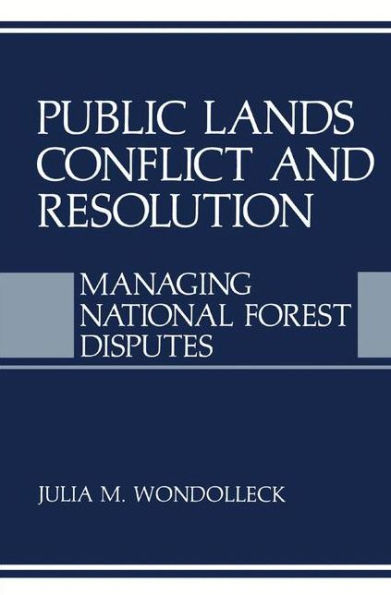Public Lands Conflict and Resolution: Managing National Forest Disputes
The United States Forest Service, perhaps more than any other federal agency, has made great strides during the past two decades revolution izing its public involvement efforts and reshaping its profile through the hiring of professionals in many disciplinary areas long absent in the agency. In fact, to a large extent, the agency has been doing precisely what everyone has been clamoring for it to do: involving the public more in its decisions; hiring more wildlife biologists, recreation specialists, sociologists, planners, and individuals with "people skills"; and, fur thermore, taking a more comprehensive and long-term view in planning the future of the national forests. The result has been significant-in some ways, monumental-changes in the agency and its land manage ment practices. There are provisions for public input in almost all as pects of national forest management today. The profeSSional disciplines represented throughout the agency's ranks are markedly more diverse than they have ever been. Moreover, no stone is left untumed in the agency's current forest-planning effort, undoubtedly the most comprehensive, interdisciplinary planning effort ever undertaken by a resource agency in the United States. Regardless of the dramatic change that has occurred in the U. S. Forest Service since the early 1970s, the agency is still plagued by con flicts arising from dissatisfaction ~th how it is doing business.
1113636201
Public Lands Conflict and Resolution: Managing National Forest Disputes
The United States Forest Service, perhaps more than any other federal agency, has made great strides during the past two decades revolution izing its public involvement efforts and reshaping its profile through the hiring of professionals in many disciplinary areas long absent in the agency. In fact, to a large extent, the agency has been doing precisely what everyone has been clamoring for it to do: involving the public more in its decisions; hiring more wildlife biologists, recreation specialists, sociologists, planners, and individuals with "people skills"; and, fur thermore, taking a more comprehensive and long-term view in planning the future of the national forests. The result has been significant-in some ways, monumental-changes in the agency and its land manage ment practices. There are provisions for public input in almost all as pects of national forest management today. The profeSSional disciplines represented throughout the agency's ranks are markedly more diverse than they have ever been. Moreover, no stone is left untumed in the agency's current forest-planning effort, undoubtedly the most comprehensive, interdisciplinary planning effort ever undertaken by a resource agency in the United States. Regardless of the dramatic change that has occurred in the U. S. Forest Service since the early 1970s, the agency is still plagued by con flicts arising from dissatisfaction ~th how it is doing business.
169.99
In Stock
5
1

Public Lands Conflict and Resolution: Managing National Forest Disputes
263
Public Lands Conflict and Resolution: Managing National Forest Disputes
263
169.99
In Stock

Product Details
| ISBN-13: | 9780306428616 |
|---|---|
| Publisher: | Springer US |
| Publication date: | 05/31/1988 |
| Series: | Environment, Development and Public Policy: Environmental Policy and Planning |
| Edition description: | 1988 |
| Pages: | 263 |
| Product dimensions: | 6.14(w) x 9.21(h) x 0.24(d) |
From the B&N Reads Blog
